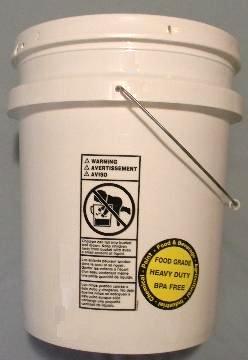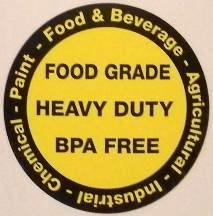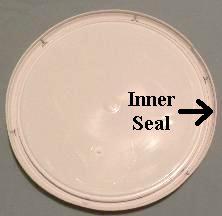
















Water Storage Options
Copyright © August 1, 2013 by Robert Wayne Atkins, P.E.
All Rights Reserved.
 If a person does not drink any water, or any beverages that contain water, then that person will die of dehydration in approximately three days.
If a person does not drink any water, or any beverages that contain water, then that person will die of dehydration in approximately three days.
Therefore, if you wish to be prepared for an unexpected hard times tragedy event, then it makes good sense to store some water in addition to your emergency food.
Water can be obtained in a variety of different ways. Let's briefly look at four of those options.
- Ground Water: Any water that is making contact with the ground will contain a variety of harmful microorganisms and chemicals that are harmful, or deadly, to the human body. Ground water should not be stored or consumed until after it has been processed to remove those harmful microorganisms and chemicals.
- City Water: The municipal water supply in most areas contains chlorine to prevent the growth of harmful microorganisms. City water also frequently contains fluoride which is a chemical that is poisonous to the human body. Most people can tolerate the small amount of chlorine and fluoride in their water but those chemicals will very slowly and gradually contribute to some long-term health issues. Therefore, although city water is better than ground water, it is not as good as the next two types of water.
- Rainwater: In most areas rainwater is safe to drink if you can collect it before it comes into contact with anything, such as trees or roofs. If you have a clean heavy-duty tarp then you can channel rainwater into a clean water storage container. The two disadvantages of rainwater are that it is not predictable and it does not contain any trace minerals that are beneficial to the human body.
- Well Water: If you have a well, and that water has been tested to be safe for human consumption, then you have an excellent source of drinking water. In most areas well water will contain trace amounts of a variety of minerals that are beneficial to the human body. However, some people do not like well water because of those trace minerals and the fact that they will gradually leave stains on the inside of your sinks and toilet bowls. I personally do not mind cleaning my sinks and toilets on a regular basis and I prefer the taste and health benefits of well water. Therefore I always refill an empty 20 ounce water bottle with well water and I take it with me to work so I will have healthy safe water to drink when I want some.
 Storing any of the above types of water for a long period of time results in a variety of problems that can be avoided if you will wait to fill most of your water storage containers until you need them. This may or may not be a strategy that will work for you. However, if you can delay the collection of most of your emergency water until you actually need it then you can avoid the problems associated with long-term water storage and with having to continuously rotate your water supply. (Note: As I have mentioned before, if you have a 40 gallon hot water heater, and that hot water heater has a drain faucet at the bottom of the heater, then your family will always have 40 gallons of fresh water in storage for an emergency, and that water will be continuously refreshed as you use your hot water during normal times. During a hard times event, turn off the power or the gas to your hot water heater, and then you can open the faucet to withdraw your 40 gallons of emergency water.)
Storing any of the above types of water for a long period of time results in a variety of problems that can be avoided if you will wait to fill most of your water storage containers until you need them. This may or may not be a strategy that will work for you. However, if you can delay the collection of most of your emergency water until you actually need it then you can avoid the problems associated with long-term water storage and with having to continuously rotate your water supply. (Note: As I have mentioned before, if you have a 40 gallon hot water heater, and that hot water heater has a drain faucet at the bottom of the heater, then your family will always have 40 gallons of fresh water in storage for an emergency, and that water will be continuously refreshed as you use your hot water during normal times. During a hard times event, turn off the power or the gas to your hot water heater, and then you can open the faucet to withdraw your 40 gallons of emergency water.)
During an on-going hard times event, water could be stored in any of the following containers.
- Case of Bottled Water containing between 20 to 36 bottles of water. Based on the number of people in your family, one case of bottled water will probably be enough to last your family three to five days depending on the size of the water bottles and the number of water bottles in a case. If bottled water is the best solution for your specific application then you should systematically rotate your supply of bottled water. The easiest way to do this is to have two stacks of bottled water on the floor of your kitchen pantry. Each time you consume a case of water out of one stack, buy a new case of water and put in on the other stack. When the first stack of bottled water is used up, then start using the bottled water from the other stack and build a fresh inventory of bottled water in the space you just emptied. (Note: Save the empty water bottles and put them back in their case so you can gradually build a supply of empty water bottles that can be refilled when you have access to clean drinking water.)
- Clean Empty 2-Liter Soft Drink Bottles. If your family consumes soft drinks in the food grade 2-liter bottles then after you consume all the soft drink you can wash the empty bottle and the cap and use the clean empty bottle for water storage. The advantage of the 2-liter bottles is that they are free after you consume the soda. The major disadvantage of the 2-liter bottles is that they won't stack on one another. In order to stack the 2-liter bottles you will need to place a piece of plywood on top of the caps of one layer of bottles, and then stack the next layer of bottles on the piece of plywood.

- 5 or 6 Gallon Food Grade Plastic Pails (or buckets). These plastic pails can be filled with water and stacked two or three pails high, depending on how strong you are and how high you can safely lift a heavy item. A five gallon pail of water will weigh about 45 pounds, and a six gallon pail of water will weigh about 54 pounds, depending on the weight of the plastic pail you use. The major advantage of food grade pails is that they nest inside one another when they are empty. Approximately 80% of a 5 gallon pail will fit inside another 5 gallon pail. This means you can store several empty food grade pails in a much smaller storage space compared to empty water bottles, or empty 2-liter bottles, or empty food grade drums. If you must move to another location then your empty pails will take up less space in your moving vehicle when compared to other types of water storage containers. A nested stack of 12 empty 5 gallon pails is approximately 58 inches high and they will need a floor space that measures 12 inches by 12 inches. When the pails are filled with water you will be able store 60 gallons of water in a two feet by two feet square of floor space if you stack the full water pails three high or approximately 44 inches high. You can purchase the 5 gallon white food grade pails near the paint department at a Lowe's Home Improvement Store for approximately $4 each. Each pail will require the purchase of a separate lid with an inner seal for about $2 each. Lowe's also sells cheaper 5 gallon pails but they are not food grade. Lowe's also sells cheaper lids that do not have an inner seal. The pails and lids I have seen at WalMart are the cheaper items and they are not food grade pails and the lids do not have an inner seal.
- 40 to 55 Gallon Food Grade Drums. A lot of people recommend and prefer food grade drums for water storage. The drum may be made of food grade plastic or it may be made of a stronger material and then the interior of the drum will be coated with a food grade lining. The major advantage of these drums is that you have a lot of water in one spot.
However, drums do have five disadvantages:
- A 40 gallon drum of water will weigh about 355 pounds, and a 55 gallon drum of water will weigh about 480 pounds, depending on the weight of the drum. This means you cannot easily move a full drum of water.
- It may not be practical to have your cooking area, and your bathing area, and your laundry area next to your water drums. Therefore you may have to walk to and from your drum area to get water and then carry that water to the location where you currently need the water.
- You will need some water pipe or a food grade water hose to refill your drums when they are empty.
- The water in the bottom half of a drum requires a little more effort to withdraw it, or you will need some type of pump to extract the water from the bottom of the drum.
- If you must move to another location then one or two empty drums will take up a lot of space in your moving vehicle. Although you can probably put some lightweight items inside the empty drum, the drum itself will still occupy a significant amount of space.
If you do not have access to a year-round supply of fresh water, then you will need to store some water for emergency use. In my opinion, the most practical solution would be to have a few cases of bottled water that you replace as your family consumes it, and some empty 5 or 6 gallon food grade pails for storing your water during an unexpected long-term hard times tragedy event. If you have several tarps then you can channel rainwater into your food grade pails each time it rains. As each pail is full you can put a lid on the full pail of water and set it aside and place another empty pail below your tarp. You can continue this process until all your pails are full of water.
If you decide to purchase one or more cases of bottled water, then may I suggest that you consider purchasing "natural spring water." Natural spring water contains a variety of trace minerals that are beneficial to the human body. "Deer Park Natural Spring Water" is currently sold in many grocery stores including many WalMarts.
Respectfully,
Grandpappy.
Grandpappy's e-mail address is: RobertWayneAtkins@hotmail.com




































 If a person does not drink any water, or any beverages that contain water, then that person will die of dehydration in approximately three days.
If a person does not drink any water, or any beverages that contain water, then that person will die of dehydration in approximately three days. Storing any of the above types of water for a long period of time results in a variety of problems that can be avoided if you will wait to fill most of your water storage containers until you need them. This may or may not be a strategy that will work for you. However, if you can delay the collection of most of your emergency water until you actually need it then you can avoid the problems associated with long-term water storage and with having to continuously rotate your water supply. (Note: As I have mentioned before, if you have a 40 gallon hot water heater, and that hot water heater has a drain faucet at the bottom of the heater, then your family will always have 40 gallons of fresh water in storage for an emergency, and that water will be continuously refreshed as you use your hot water during normal times. During a hard times event, turn off the power or the gas to your hot water heater, and then you can open the faucet to withdraw your 40 gallons of emergency water.)
Storing any of the above types of water for a long period of time results in a variety of problems that can be avoided if you will wait to fill most of your water storage containers until you need them. This may or may not be a strategy that will work for you. However, if you can delay the collection of most of your emergency water until you actually need it then you can avoid the problems associated with long-term water storage and with having to continuously rotate your water supply. (Note: As I have mentioned before, if you have a 40 gallon hot water heater, and that hot water heater has a drain faucet at the bottom of the heater, then your family will always have 40 gallons of fresh water in storage for an emergency, and that water will be continuously refreshed as you use your hot water during normal times. During a hard times event, turn off the power or the gas to your hot water heater, and then you can open the faucet to withdraw your 40 gallons of emergency water.)

